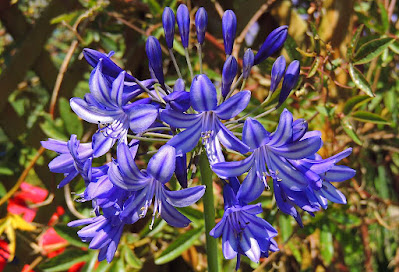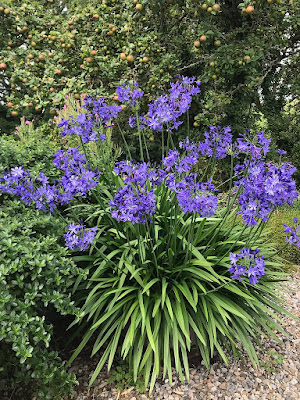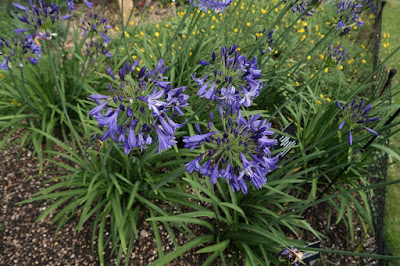Agapanthus Northern Star - Northern Star Lily of the Nile is characterized by green leaves with a violet base and a large number of violet flowers...
Agapanthus Northern Star also called as Northern Star Lily of the Nile, is a cultivar in the genus Agapanthus. This cultivar was discovered by Richard John Fulcher in an outdoor garden in Fourways, Eggesford, Devon, United Kingdom in the Summer of 1998.
DESCRIPTION OF AGAPANTHUS NORTHERN STAR - NORTHERN STAR LILY OF THE NILE
Agapanthus Northern Star is originated from a chance open pollination of a group of unnamed Agapanthus cultivars. Asexual reproduction of the plant first occurred by tissue culture in 2002 in Fourways, Eggesford, Devon, United Kingdom. Since that time, under careful observation, the unique characteristics of the plant have been uniform, stable and reproduced true to type in successive generations of asexual reproduction.
It is a herbaceous perennials which reaching 100 cm tall by 80 spread and grows in upright clumps from fleshy rhizomes that produce short, tuberous roots. Tufts of leaves are produced on short stems. The leaves are leathery, linear, acute apex, cuneate base, 57.5 cm long by 22.5 cm wide, entire margin, green colored with a violet base.
Northern Star Lily of the Nile bloom primarily in August in umbels on erect, 18 cm long scapes with about 150 flowers per scape. The flowers are violet, campanulate, 3 cm in diameter by 3.3 cm long and last approximately 5 weeks on the plant and about 10 days as cut flowers. The flowers are held on the 90 cm long, green, strong peduncle.
AGAPANTHUS NORTHERN STAR - NORTHERN STAR LILY OF THE NILE CARE AND CULTURE
Cultural information should only be used as a guide, and should be to be adapted to suit you. Your physical location; where you grow your plants, how much time you have to devote to their care, and many other factors, will need to be taken into account. Only then can you decide on the cultural methods that best suit you and your plants.
Light:
Agapanthus Northern Star thrive in full sun and need 6-8 hours of sunlight each day. They can be grow as a houseplant in bright light and requires good lighting in the summer, with a lack of light, the flower stalks are extended, and they need support. They grows best at a window with a south, southeast, or southwest orientation. This plant blooms best when grown in full sun.
Temperature:
Northern Star Lily of the Nile need the cool to cold temperatures. In summer, the optimal temperature is at around 25 ℃. In winter a low temperature of 10-12 ℃ is desirable. When temperatures dip below freezing, the plant will require some winter protection, a few layers of horticultural fleece can also be thrown over the leaves. The plant grown in containers can moved to a frost-free greenhouse or a conservatory for the winter.
Substrate and growing media:
Agapanthus Northern Star is planted just deep enough to cover the roots, spacing them about 8” apart. A single plant will fill a 12” pot, or use more in larger pots. Use well-drained potting mix, as they do not tolerate waterlogged soil. For good growth and abundant flowering the plant requires a nutrient mixture of clay-sod, humus, leaf soil and sand (2: 2: 1: 1).
Young and medium-sized plants are transplanted every spring, adult plants every 3-4 years. The plant does not like frequent transplants, blooms best in a close pot. When transplanting, be careful, as the rhizomes are carelessly broken when carelessly applied and the plant may not tolerate the transplant.
Watering:
Keep the plant well watered when growing, but allow it to dry out in winter. Making sure that the substrate does not dry out completely. If watering is excessive, water may stagnate, which leads to acidification of the soil.
Fertilizer:
During the growing season, the plant can be fertilize every 10 days (April to October). In the winter, during the rest period the plant is not fed.
Rest period:
Agapanthus Northern Star is keeped outdoors as long as possible in the fall because they need a cold period in order to flower well the next season. However, do not subject your plants to heavy frost (28ºF). In winter the plant should be place indoors in a cool location with bright light such as in a mudroom, by a window in a garage that does not freeze, or in a room that is kept cool (45ºF - 55º F). Keep your plant on the dry side, watering perhaps once a month. If plants are kept too warm during the winter they will force into bloom before summer.
In winter, reduce watering and do not fertilize during this time. In the spring, after danger of frost has passed, place your plant outdoors, gradually moving them from part sun to full sun, and begin watering and fertilizing regularly.
Propagation:
Northern Star Lily of the Nile can be propagated from division. Root bound potted plants can be divided every 4-5 years. Division is best done after flowering, but it can be done any time. Use a very sharp knife to cut the clump into sections, each with roots attached, and pot the sections up. Divisions may not flower until the following year.

















COMMENTS